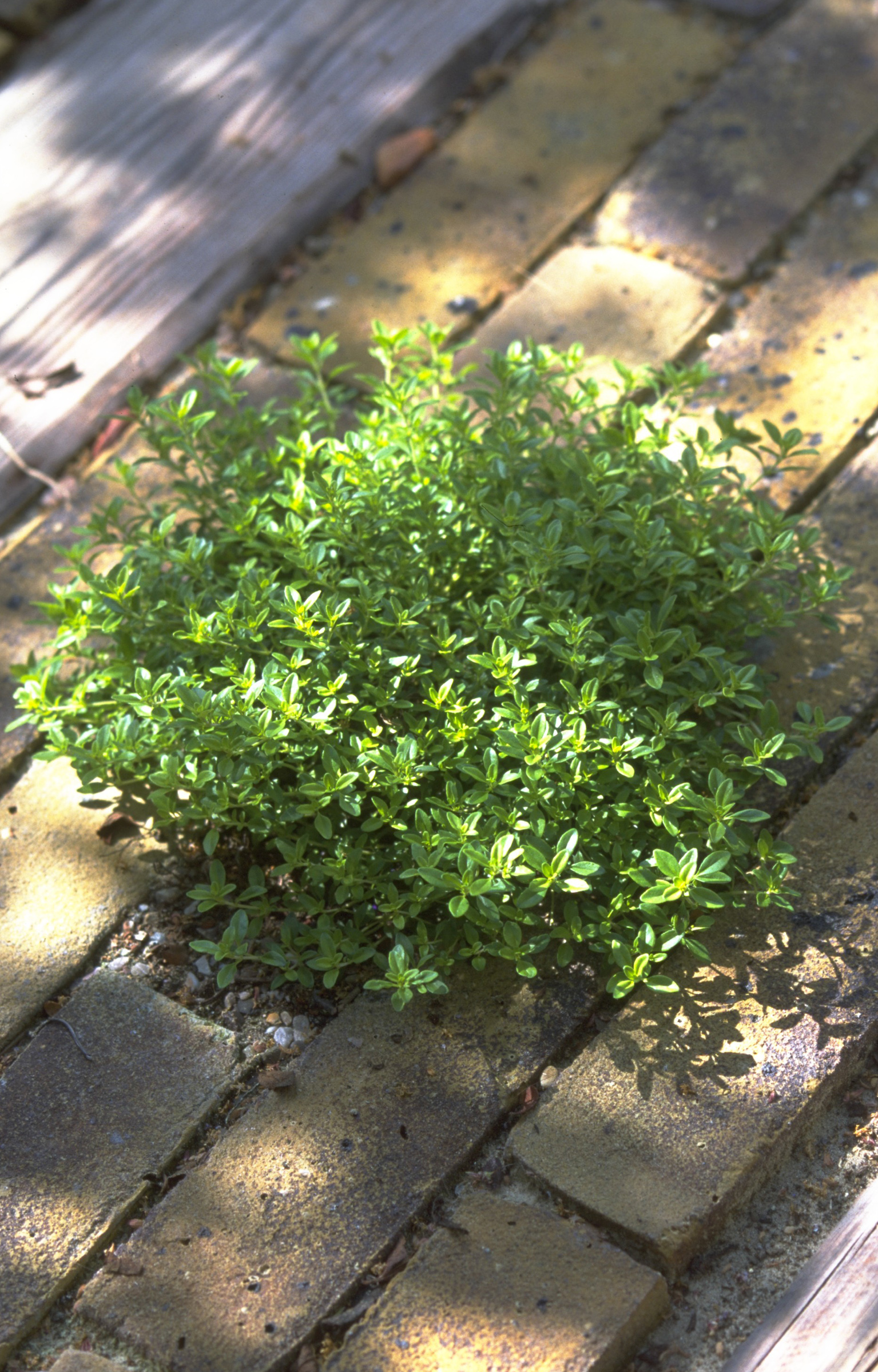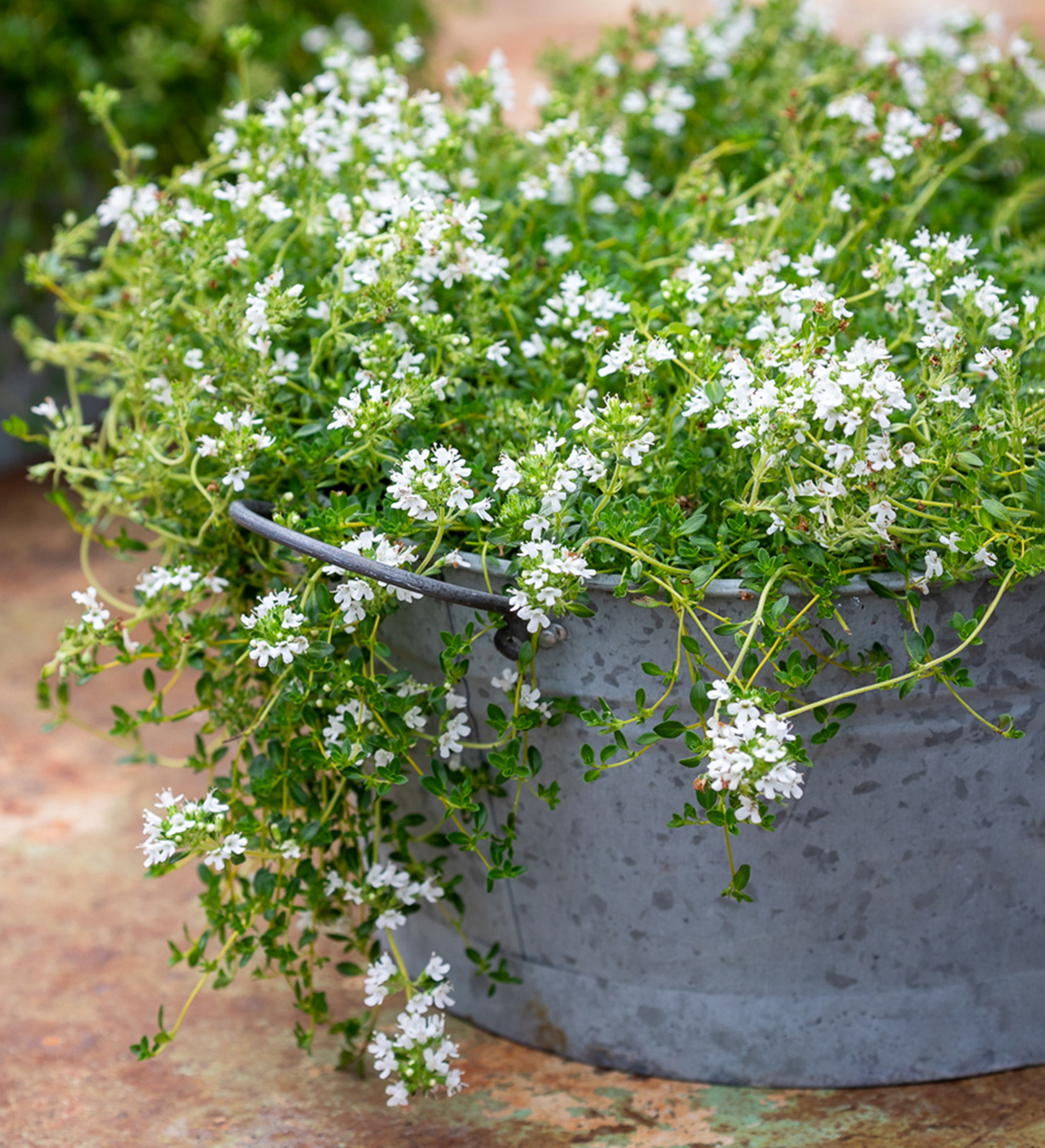How to grow thyme: this pretty herb adds fragrance and flowers to the garden
Follow our advice on how to grow thyme successfully and this Mediterranean herb will repay you by becoming one of the go-to plants in your edible garden


Find out how to grow thyme and you'll be rewarded with an easy happy-go-lucky herb that will soon become a firm favourite. One of the mainstays of the Mediterranean garden, it's not difficult to grow. Give it a patch of dry, stony soil and plenty of sun then just leave it to romp away. It will also pop up in the cracks between pavers to soften the edges.
There are loads of different varieties to choose from (around 200 – who knew!) including the main ones used for cooking as well as ground hugging ornamental ones that thrive in gravel gardens and alongside garden paths. It's a good 'spiller' choice for hanging baskets and window boxes too, as the waves of foliage gently tumble over to create a soft look.
A few snips will transform your cooking. But it's not just about the heavenly scented leaves though. Did we mention the flowers? Thyme produces masses of pretty flowers in white, pink, crimson and lilac-blue throughout the summer months that are well worth celebrating in their own right.
Read on to find out more and don't miss our tips on how to create a herb garden if you want to add more fragrant and tasty plants to your plot.

'Tabor' is a vigorous creeping variety with large, rounded glossy leaves and mauve flowers that are particularly attractive to bees
HOW TO GROW THYME

Fresh thyme can be used to enhance summer dishes
- Thyme is an easy-to-grow Mediterranean herb that fills the air with scent on a sunny day.
- Plant out in spring for the best results.
- Thyme likes well-drained soil and will thrive in poor sandy soil.
- Choose a sunny, sheltered spot for it.
- Suffers in cold winds and wet winters but will be happy on a windowsill when things get chilly in the garden.
- Will thrive in patio pots too.
- It's one of the great bee friendly plants – bees love its fragrant flowers and it's a magnet for all pollinating insects.
- Can be propagated from cuttings.
- Clip immediately after it has finished flowering to keep the bush looking neat.
- Available in ornamental creeping varieties too.
Is thyme easy to grow?

Thyme grows happily in between pavers, taking hold easily in cracks and crevices
Thyme is one of the easiest herbs to grow and will spread about in the garden freely as well as making a feature in your container gardening ideas. It's a robust little plant that doesn't need cosseting.
It's so tough you can even use it to create an alternative to lawn. In the same way as chamomile it will take a small amount of walking on. Choose a creeping red variety like 'Coccineus' for a showy carpet effect.
Where does thyme grow best?

Thyme thrives in pots on a sunny patio
Give thyme the right conditions and it will live for years. Always choose a sunny spot that's sheltered. If in doubt think Mediterranean planting conditions and you'll get it right.
If you opt to grow thyme in patio pots you can move them around to follow the sun if your garden doesn't have the best aspect. Mix plenty of grit into the compost to replicate the dry and sandy soils it likes best, as well as including crocks in the base of the pot.
Thyme also works well for hanging basket ideas and window box ideas if space is limited. It doesn't have to be planted with other herbs – you can mix it in with flowers and vegetables too.
If you're planting thyme in the ground choose the sunniest spot in the garden and make sure the soil is well drained if thyme is to thrive. Remember: treat it mean.
How do you grow thyme successfully?

Move pots of thyme around to catch the sun
As well as choosing a hot spot for thyme and planting it in well-drained soil, you need to cut it back hard after flowering. If you don't your plant will become tired, woody and straggly. Every three or four years it's a good idea to lift out your thyme and divide it into smaller plants to keep it vigorous, composting any that are clearly past their sell-by.
Thyme doesn't need a lot of watering either as it's used to growing in drought conditions. Just keep an eye on pots if it's especially hot. Conversely if it's rainy make sure you lift them off the ground on pot feet to allow for easy drainage so your thyme isn't sitting in waterlogged soil.
Does thyme grow back every year?

Keep your plants healthy by lifting them out and dividing them every three or four years
Thyme is a perennial plant, which means it comes back every year if grown in the right conditions. Help it along by trimming right back after flowering and regenerating the plant by lifting out and dividing every three to four years.
Sometimes it may be necessary to replace it after a while if it's looking woody and jaded. But remember it's an easy plant to propagate. By taking cuttings from soft new growth anytime between May and July you can easily become self-sufficient in thyme for years to come.
There's more tips on how to take cuttings from plants in our guide.
What type of thyme is best?

Lemon thyme has a lovely citrusy scent
There is a huge variety of thyme plants to choose from including the common garden variety (thymus vulgaris) with its pretty dark green foliage and mauve flowers.
You can also get variegated varieties where the leaves are shot through with silver or gold. Or try lemon and orange scented thyme varieties, or even thyme fragranced with caraway.
- Lemon thyme – good for cooking
With a lovely citrusy scent and transformative powers when it comes to adding it to your cooking, this is a firm favourite. Keep snipping the leaves for culinary use and to keep the plant tidy. - 'Jekka' – good all rounder
This is good for the kitchen and has a lovely taste. It flowers much earlier than other thyme varieties and for longer. When deadheaded and trimmed back after flowering it quickly leafs up then flowers again. It's a great option as one of the best edging plants for a path too. - Creeping white thyme – good for pots
This grows happily in pots for years but will do equally well in the garden. Keep an eye on the soil though to make sure it doesn't dry out. - Coccineus – best for ground cover
This is an excellent choice for a thyme carpet and forms a flat mat of glossy leaves. The deep pink flowers are highly attractive to bees. Great for paving ideas as you can grow it between paving where it will release its lovely scent when trodden on. - 'Silver Queen' – best variegated option
The small dark leaves are tinged with silver and it's covered with tiny pink flowers in summer. It's a spreading evergreen, good for edging paths as well as using to fill gaps in between pavers. Step on it and it will release its beautiful scent.
When is the best time of year to plant thyme?

Plant thyme in among your flowers
Plant out ready-grown plants in mid- or late spring. Add a ring of horticultural grit or gravel around them to protect them if the soil is too wet otherwise the leaves can rot.
If you're growing tender young plants in pots keep them indoors on a windowsill if there is any chance of late frosts that might harm them.
You can also grow thyme from seed in early spring. Use small pots filled with seed growing compost and place in a propagator to germinate. Transfer to individual pots once the seedlings are large enough to handle. There's tips on how to do this in our guide on how to transplant seedlings.
How to prune thyme

This one is easy. Using your best secateurs clip your thyme into shape as soon as it's finished flowering. Aim for a nice rounded compact shape that looks neat, tidying up any stragglers as you go.
If you find a lot of woody growth and not much sign of green growth it might be best to consign your plant to the compost heap and start again with a new plant.
How to propagate thyme

'Old English' is an aromatic, evergreen thyme that will grow anywhere: containers, rock gardens, borders, even cracks in paving. Ideal for creating low, mat-forming groundcover
- Thyme can easily be divided or propagated by taking cuttings in late spring for propagation of additional thyme plants.
- Take your cutting at a node on the stem where the leaves attach.
- Strip off the lower leaves then push the cut end into a pot of gritty soil mix.
- Transfer to a warm place and keep the soil slightly damp.
- Another way of propagating thyme easily is by layering. Simply bend a stem down to the ground, remove any leaves and secure it in place by pegging it. Cover with soil and water in well.
Where to buy thyme

'Old English' thyme
Thyme plants are widely available from garden centres and online during spring and summer. Plants are usually sold in small pots ready for planting out.
Where to buy thyme in the UK:
- Shop thyme at Amazon
- Shop thyme at Crocus
- Shop thyme at Dobies
- Shop thyme at Suttons
- Shop thyme at Thompson & Morgan
- Shop thyme at Waitrose Garden
Where to buy thyme in the US:
4 varieties of thyme to try in your garden

With so many wonderful varieties to choose from you’re spoiled for choice. Here's a round-up of some of our favourite thyme varieties.
Thyme 'Jekka' from Crocus
Introduced by herb grower Jekka McVicar, this is an outstanding thyme that has one of the best flavors. Use the leaves to jazz up chicken, fish and vegetable dishes. The small pink or white summer flowers help attract beneficial pollinating insects.
Thyme 'Silver Queen' from Dobies
With small, ovate, dark green leaves edged with creamy white and clusters of tiny pale mauve flowers ‘Silver Queen’ makes an eye-catching addition to beds, borders and patio pots. It has a spreading habit so is a good choice for edging paths.
Thyme 'Andersons Gold' from Suttons
A lovely plant with many uses from brightening up gravel paths to mixed borders or even a complete lawn. This herb is also one of the most useful additions to the kitchen. ‘Andersons Gold’ has a slight lemon flavour that will truly enhance your cooking.
Lemon thyme from Amazon
Excellent plant for borders and around paving, as well as planting in gravel and containers. Hardy and evergreen, the flowers are popular with bees through the long flowering season from May to October. Use to beautifully enhance many recipes.

Lifestyle journalist Sarah Wilson has been writing about gardens since 2015. She's written for Gardeningetc.com, Livingetc, Homes & Gardens, Easy Gardens and Modern Gardens magazines. Having studied introductory garden and landscape design, she is currently putting the skills learned to good use in her own space where the dream is establishing a cutting garden.




